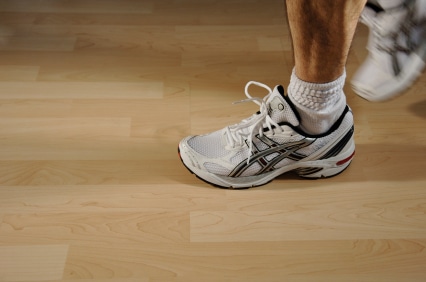 When aerobics first hit the Gym scene about three decades ago there were very few choices available for aerobic flooring. Our first heath club’s aerobic floor consisted of a concrete floor covered by a thin pad topped-off by carpet. It is little wonder that hardly a week went by that an instructor was not injured from shin splints or a sprained ankle.
When aerobics first hit the Gym scene about three decades ago there were very few choices available for aerobic flooring. Our first heath club’s aerobic floor consisted of a concrete floor covered by a thin pad topped-off by carpet. It is little wonder that hardly a week went by that an instructor was not injured from shin splints or a sprained ankle.
The secret to a good aerobics floor is to purchase or make a floor that has a good energy return system, absorbs shock and offers good lateral foot support. This means you want a floor that absorbs the energy when you land on it but then snaps back much in the same way a diving board or trampoline works. You need to have all three components combined in your flooring choice to help prevent injury:
Absorption
All aerobic activity generates energy. Walking, jumping, hopping, skipping even the impact of standing still (gravity). Energy directly returned to the body is bad. Shin splints, back and knee problems, fatigue, strains and even broken foot bones can result. A non-energy absorbent floor or flooring system is dangerous. It can result in injury and law suits. Concrete is non energy absorbent. Any substance put directly on concrete does not remove you from the concrete unless it contains air (like foam). Basket weave subfloors and foam or spring floating subfloors provide shock absorbent characteristics that eliminate the problems associated with hard, non absorbent floors.
Resilience
In addition to energy absorbency, energy can be dissipated by resiliency. (think of a diving board or a mini-trampoline), energy transfers from your body to a subfloor that deflects and safely returns energy (spring). Wood is considered by many as the best of the resilient materials.
Lateral Foot Support
In addition to the absorbent and resilient nature of your subfloor, perhaps the most important and most overlooked attribute is lateral foot support. Try standing on one leg on a resilient trampoline. No lateral foot support, no balance. Sink into an absorbent floor and you increase your chances of turning an ankle. Today, the leading cause of injury is not shin splints, but ankle injury, due in part to flooring systems that rely solely on absorbent materials or systems that are too spongy. Warning: any floor/floor system that you can squish together in your hands (feels soft) can be dangerous due to lack of lateral foot support! In the same way you don’t want a bed that is too soft, you also don’t want an aerobic floor that is too soft either.
In our own club and studio set you see in all of our videos we use a specially designed subfloor that consist of two thin layers of specialty plywood that is elevated on thousands of rubber energy return blocks. The result is an air cushion with the response of an air mattress that is almost therapeutic This type of flooring has a great energy return system. We have found this type of flooring to best for step and high impact aerobics. The entire subfloor is covered with a thin commercial carpet or vinyl. The total cost of this type of flooring (excluding carpet or vinyl) varies but can be done for as little as $2.50 to $3.00 per sq ft depending on the design. These prices are an average for the wood, screws, hardware, glue and rubber blocks. Does not include any labor costs. The rubber energy return blocks as well as complete plans may be purchased from companies like Gerstung and Stage Step
If you are mainly into floor aerobics you may prefer to try a suspended hardwood floor. This is because quick turning movements are more safely performed on a hardwood surface than on carpet. There are many companies that can provide you with everything you need for this type of flooring. Costs for this type of flooring is very high and can easily cost at least $12 00 per sq ft
Another alternative is a floor that made by companies like aesonflooring.com, floorscore.com, Sport Court or greatmats.com. These are square rubber systems that are very easy to install and move. This type of flooring utilizes specially designed rubber tiles that snap easily together.
Remember, safety is the number one issue with home exercisers when it comes to flooring. The first safety concern is the degree of non-slip. The second safety issue is absorption and resilience. If the floor is not absorbent, the body becomes the shock absorber, resulting in fatigue, pain and injury. Keep these things in mind when you’re ready to purchase or make your own shock absorbing floor system and your body will love you.

